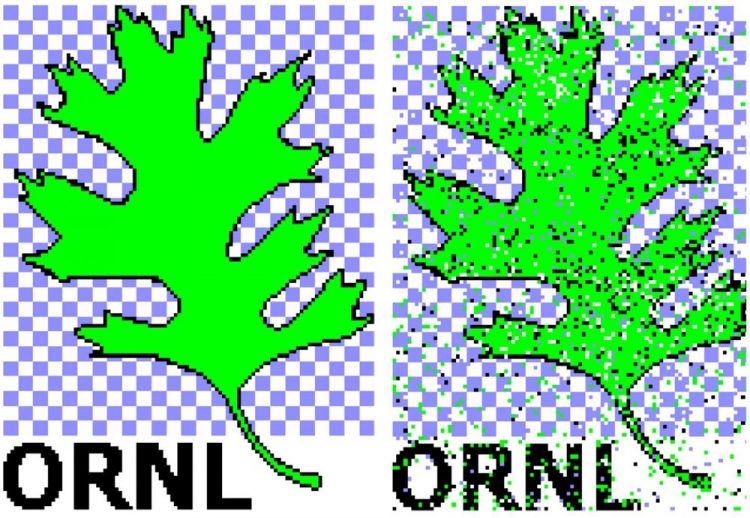ORNL researchers break data transfer efficiency record

The team transmitted the ORNL logo, an oak leaf, between two end points in the laboratory with 87 percent calculated fidelity. (Left): The original 4-color, 3.4kB image. (Right): The image received using superdense coding. Credit: ORNL
The ORNL team transferred 1.67 bits per qubit, or quantum bit, over a fiber optic cable, edging out the previous record of 1.63 per qubit.
The work by ORNL's Brian Williams, Ronald Sadlier and Travis Humble is published as “Superdense coding over optical fiber links with complete Bell-state measurements” in Physical Review Letters. The research was selected as an “Editor's Suggestion,” a distinction reserved for approximately one in six PRL papers.
Whereas computers transmit information in the form of bits (generally represented by either a 1 or a 0), qubits can employ two states simultaneously and therefore represent more information than a traditional bit. The physics of this quantum communication task employed by Williams and his team is similar to that used by quantum computers, which use qubits to arrive at solutions to extremely complex problems faster than their bit-laden counterparts.
Williams' team was the first to use superdense coding over optical fiber, a major achievement in the quest to adopt quantum communication to modern networking technology. And because the team used conventional laboratory equipment such as common fiber optic cable and standard photon detectors, they have brought the technique one step closer to practical use.
As a demonstration of the technique's effectiveness, the team transmitted the ORNL logo, an oak leaf, between two end points in the laboratory.
While the technology is at present largely experimental, practical applications could include a cost-effective way to condense and transfer information. This includes more efficient methods for transmitting and receiving data in application areas such as the Internet and cybersecurity.
“This experiment demonstrates how quantum communication techniques can be integrated with conventional networking technology,” Williams said. “It's part of the groundwork needed to build future quantum networks that can be used for computing and sensing applications.”
###
The work was supported by the United States Army Research Laboratory.
UT-Battelle manages ORNL for the DOE's Office of Science. The Office of Science is the single largest supporter of basic research in the physical sciences in the United States, and is working to address some of the most pressing challenges of our time. For more information, please visit http://science.
Image: https:/
Caption: The team transmitted the ORNL logo, an oak leaf, between two end points in the laboratory with 87 percent calculated fidelity. (Left): The original 4-color, 3.4kB image. (Right): The image received using superdense coding.
NOTE TO EDITORS: You may read other press releases from Oak Ridge National Laboratory or learn more about the lab at http://www.
Twitter – http://twitter.
RSS Feeds – http://www.
Flickr – http://www.
YouTube – http://www.
LinkedIn – http://www.
Facebook – http://www.
Media Contact
All latest news from the category: Information Technology
Here you can find a summary of innovations in the fields of information and data processing and up-to-date developments on IT equipment and hardware.
This area covers topics such as IT services, IT architectures, IT management and telecommunications.
Newest articles

A new puzzle piece for string theory research
Dr. Ksenia Fedosova from the Cluster of Excellence Mathematics Münster, along with an international research team, has proven a conjecture in string theory that physicists had proposed regarding certain equations….

Climate change can cause stress in herring larvae
The occurrence of multiple stressors undermines the acclimatisation strategies of juvenile herring: If larvae are exposed to several stress factors at the same time, their ability to respond to these…

Making high-yielding rice affordable and sustainable
Plant biologists show how two genes work together to trigger embryo formation in rice. Rice is a staple food crop for more than half the world’s population, but most farmers…



